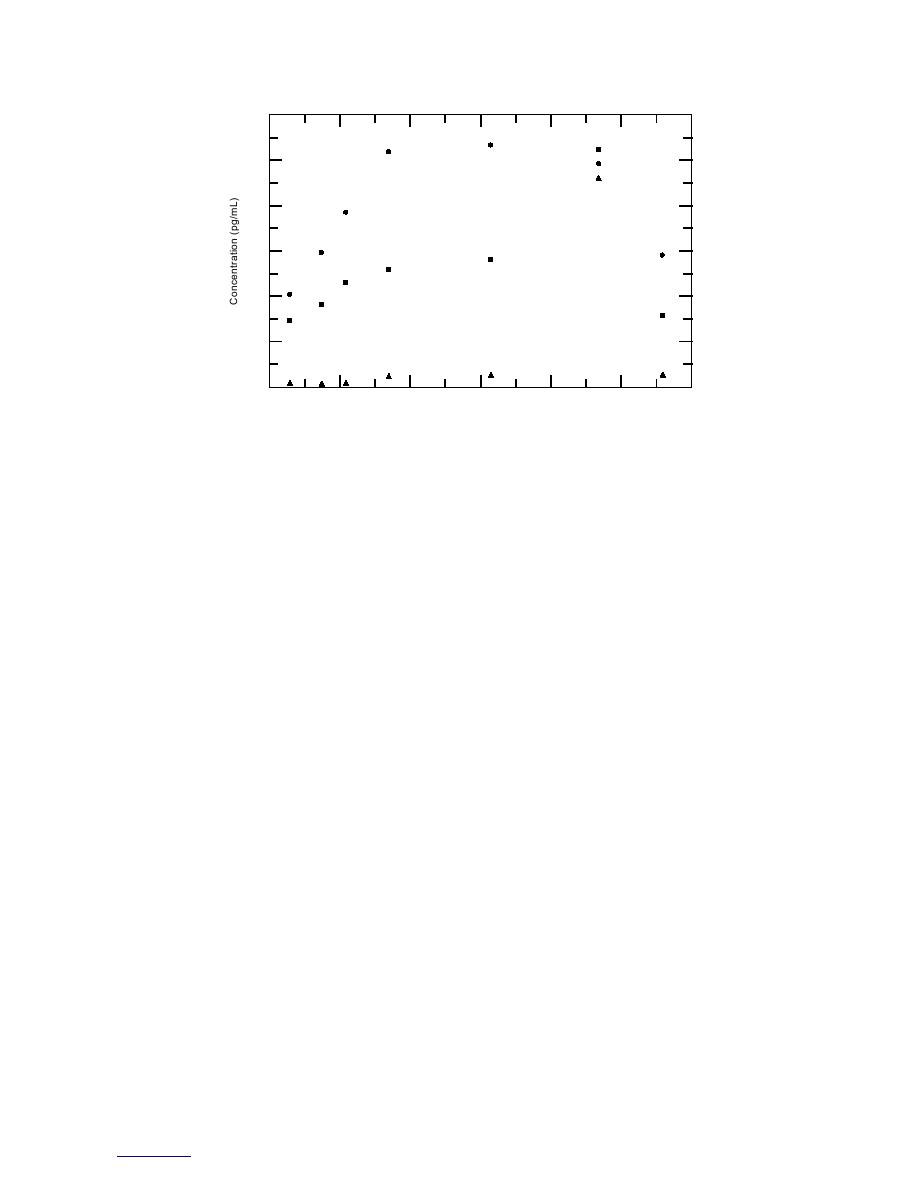
60
1,3-DNB
50
2,4-DNT
2,4,6-TNT
40
30
20
10
0
0
120
20
40
60
80
100
Sampling Time (days)
Figure 12. Concentration of analytes in the headspace vapor above 5.8% moist
silt containing buried TNT at 23C.
sample at 23C was again greatest for 2,4,6-TNT.
the concentration of either 1,2-DNB or 1,3,5-TNB
For the clayey soil maintained at 4C, the vapor
exceeded that for 2,4,6-TNT.
concentrations were reduced to less than detec-
The vapor concentrations of target analytes in
tion limits for all analytes except 2,4-DNT, 1,3-
the headspace above the air-dried soils were
DNB, 1,2-DNB, and 2,4,6-TNT. Even after 111
much lower than those above the moist soils. In
fact, only at 23C above the Ottawa sand (Table 8)
days, vapor concentrations of 2,4-DNT and 1,3-
DNB were only 1.00 and 1.34 ng/L, respectively,
were target analytes routinely measurable in the
for the low-moisture-added case, and the concen-
vapor (concentrations exceeding 0.01 ng/L).
tration of 2,4,6-TNT was less than 0.03 ng/L.
After 63 days, for example, the vapor concentra-
At 12C, vapor concentrations were further
tions of 2,4-DNT, 1,3-DNB, and 2,4,6-TNT were
reduced; only for the moist Ottawa sand did vapor
34.9, 66.5, and 3.19 ng/L, respectively. For moist
concentrations exceed detection limits (0.01 ng/
soils, the vapor concentrations of 2,4-DNT gener-
L). At 110 days for the low-moisture sand sample,
ally exceeded those of 1,3-DNB, but for air-dried
vapor concentrations of 2,4-DNT, 1,3-DNB, and
soils, vapor concentrations of 1,3-DNB generally
1,2-DNB were 1.38, 7.76, and 0.83 ng/L, respec-
exceeded 2,4-DNT.
At lower temperatures (4 and -12C), vapor
tively, and the concentration of 2,4,6-TNT was be-
concentrations were much lower than at 23C,
low detection limits. While all concentrations
were greatly reduced from 4C, the reductions
reflecting the exponential dependence of vapor
were greater for 2,4-DNT and 2,4,6-TNT, com-
pressure on temperature. For example, the vapor
pared with the more volatile 1,3- and 1,2-DNB.
concentrations of 2,4-DNT, 1,3-DNB, and 2,4,6-
TNT above the Ottawa sand at 4C were only
Accumulation of explosives residues
82.0, 47.8, and 2.28 ng/L for the low-moisture-
on surface soils
added case at 111 days. This was about an order
After the time course of the vapor sampling
of magnitude reduction from that found for the
corresponding sample held at 23C for 2,4-DNT
was completed, the vials were opened and the
top 5 mm of surface soil was carefully removed
and 1,3-DNB, and an even greater reduction for
and analyzed to determine the concentrations of
the less volatile 2,4,6-TNT. For the silty soil, a sim-
ilar reduction from 23C was also observed for
target analytes that had migrated to the surface.
the 4C samples. For example, vapor concentra-
There were two replicates for each combination
of soil type, moisture status, and temperature.
tions of 2,4-DNT, 1,3-DNB, and 2,4,6-TNT were
One replicate for each combination was sampled
9.38, 9.29, and 0.18 ng/L, respectively, for the silty
on day 63, just after the vapor was sampled with
soil with low moisture added at 111 days. The
a SPME fiber. Surface soil from the second repli-
magnitude of reduction from the corresponding
17
To Contents



 Previous Page
Previous Page
